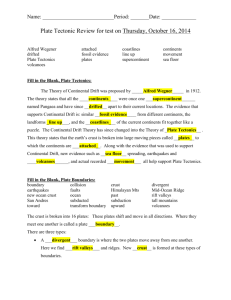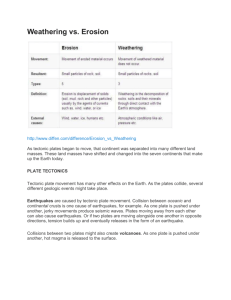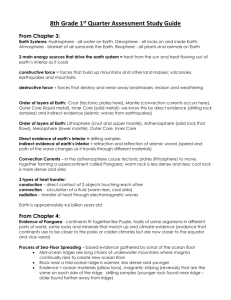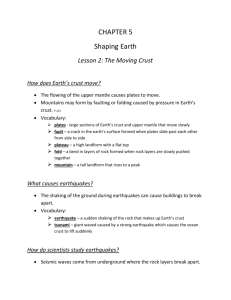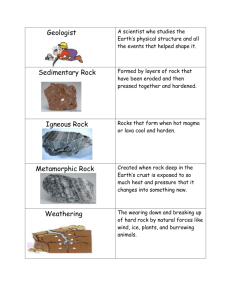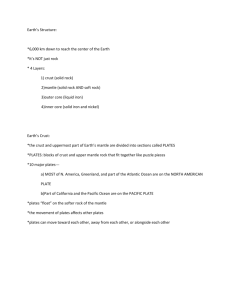Plate Tectonics Study Guide TEST/SUMMATIVE
advertisement
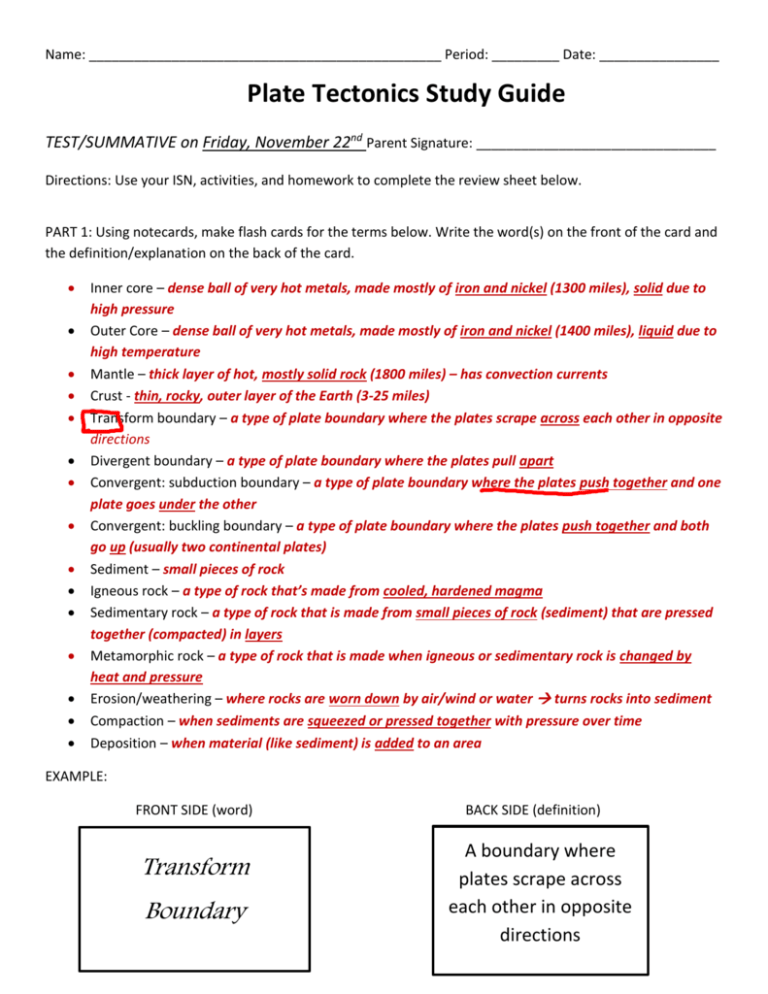
Name: _______________________________________________ Period: _________ Date: ________________ Plate Tectonics Study Guide TEST/SUMMATIVE on Friday, November 22nd Parent Signature: ________________________________ Directions: Use your ISN, activities, and homework to complete the review sheet below. PART 1: Using notecards, make flash cards for the terms below. Write the word(s) on the front of the card and the definition/explanation on the back of the card. Inner core – dense ball of very hot metals, made mostly of iron and nickel (1300 miles), solid due to high pressure Outer Core – dense ball of very hot metals, made mostly of iron and nickel (1400 miles), liquid due to high temperature Mantle – thick layer of hot, mostly solid rock (1800 miles) – has convection currents Crust - thin, rocky, outer layer of the Earth (3-25 miles) Transform boundary – a type of plate boundary where the plates scrape across each other in opposite directions Divergent boundary – a type of plate boundary where the plates pull apart Convergent: subduction boundary – a type of plate boundary where the plates push together and one plate goes under the other Convergent: buckling boundary – a type of plate boundary where the plates push together and both go up (usually two continental plates) Sediment – small pieces of rock Igneous rock – a type of rock that’s made from cooled, hardened magma Sedimentary rock – a type of rock that is made from small pieces of rock (sediment) that are pressed together (compacted) in layers Metamorphic rock – a type of rock that is made when igneous or sedimentary rock is changed by heat and pressure Erosion/weathering – where rocks are worn down by air/wind or water turns rocks into sediment Compaction – when sediments are squeezed or pressed together with pressure over time Deposition – when material (like sediment) is added to an area EXAMPLE: FRONT SIDE (word) Transform Boundary BACK SIDE (definition) A boundary where plates scrape across each other in opposite directions PART 2: Answer the following questions. Please use complete sentences and restate the question in your answer. 1. Draw a diagram of the four different layers of the Earth. Label the layers and write their composition and state of matter. Crust – thin layer of solid rock Mantle – mostly solid but has some hot, flowing rock/magma (convection currents) Outer Core – Liquid iron and nickel Inner Core – Solid iron and nickel 2. Explain what convection currents are and include a color drawing. Convection currents is a cycle where hot magma rises, and then it cools and sinks – this is what moves the plates. 3. Using the map of the world below, conclude where the majority of volcanoes and earthquakes occur (represented by black dots on the map). The majority of the volcanoes and earthquakes appear to occur on or near plate boundaries – where two tectonic plates meet. 4 – 11. Fill out the chart below about plate boundaries. Be able to compare and contrast them on the test. Type of Boundary Draw a diagram/picture that shows how the plates move 4. 5. Trenches, earthquakes, and volcanoes occur because when one plate goes under the other, the pressure forces the magma up. Also, the friction of the plates can cause earthquakes. 6. 7. Mountains occur because the crust is pushed up by the buckling. 8. 9. Mid-ocean ridges and rift valleys occur because where the plates pull apart, a large gap grows between them. This creates new sea floor in the ocean. 10. 11. Earthquakes happen because when the plates slide past each other, pressure builds up, and when the plates slip, it causes the ground to shake. Convergent Boundary (subduction) Convergent Boundary (buckling) Divergent Boundary Transform Boundary What geologic activity occurs here and why 12. At divergent boundary on the ocean floor, new crust is created – explain how/why that happens. Include a drawing to support your answer. On the ocean floor, new crust is created when plates diverge (pull apart) because magma from the mantle is forced up between the plates. It then cools, hardens, and turns into new crust. 13. Summarize three of the pieces of evidence that led Alfred Wegener to develop the theory of plate tectonics. (Hint: Use your Pangaea puzzle activity) The shape of the continents appear to fit together, especially South America and Africa Fossils from the same dinosaur species, Cynognathus and Mesosaurus, were found on multiple continents Fossils from the same plant species, Glossopteris fern, were found on multiple continents 14. Explain what Pangaea was and make a prediction about the movement of the tectonic plates in the future. Scientists hypothesize that millions of years ago there was a large land mass or super-continent called Pangaea. They believe that all of the continents used to be connected and have moved apart throughout history. In the future, many believe that they will continue to move in the same direction and eventually meet on the other side of the planet. PART 3: Complete the rock cycle diagram. *NOTE: The numbers below match the STAGE of the numbered process in the diagram above. 1. Explain WHERE the process from MAGMA to IGNEOUS ROCK could occur. Igneous rock occurs near a volcano, seafloor spreading, or a subduction zone. 3. Explain HOW the process from IGNEOUS ROCK to SEDIMENT occurs. Weathering (wind, freezing, snow, glaciers) and erosion, breaks down rock into pieces called sediment. 4. Explain HOW the process from SEDIMENT to SEDIMENTARY ROCK occurs. Through deposition (moving sediment to area), compaction, and cementation, sedimentary rock forms. 4. Explain WHERE the process from SEDIMENT to SEDIMENTARY ROCK could occur. The formation of sedimentary rock occurs near water sources. Example: ocean floor.
